Skimmer avians tend to live in co-ed settlements, with a bright hegemony in control of the government and subsidized housing and essentials for duns who are raising young. Typically, skimmers live in apartments and houses alone or with children in large housing blocks, and housing blocks/buildings are frequently either majority dun or majority bright. Brights are usually entirely uninvolved in the raising of children outside of a kind of universal “alimony” tax on adult brights.
Despite this, for most skimmers, inheritance happens through their dunparent’s family line. Most skimmers consider brights their giving inheritance to direct offspring as something only royalty is allowed to do, though there is some practicality to it as skimmer avians generally have no way to know for certain if their eggs are the ones a dun decided to keep to term after a mating season. Generally, inheritance goes from brights to their siblings, children of their dunsiblings, or to trade apprentices they select. Brights in positions of power are often known to obfuscate their affairs and surreptitiously pay their favorite dunmates to ensure exclusive parentage, in order to then take their offspring as apprentices without attracting the ire of the aristocracy.
Flightless avian duns and brights tend to live in separate self-governing settlements, though some brights form small nomadic bands instead. During spring, groups of brights will come “caroling” to dun settlements to display their tails, socialize, and court partners. Outside of the courting season, brights visiting dun settlements will typically wear long garments to cover their tails as a signal that they are there for business. Children are raised in dun communities but upon becoming adults, brights are typically ousted, though some Hotsuuv dun cities allow brights to remain if they shear their tail feathers and do not court duns.
Diver avians live in co-ed communities, with multigenerational families often occupying large longhouses, though there are some bright-only houses composed of individuals who immigrated from different islands. Brights involve themselves in raising their dunparent family’s children, but not the children of their courting partners. Although individual houses tend to be governed by duns, elder brights tend to govern settlements and may also live apart from their family as a display of impartiality.
Polar avians live in large co-ed communities with entire cities frequently occupying a single building, although individual adults tend to occupy separate apartments within it. They are the only avian species where adult brights are expected to be directly involved in the rearing of their children, with duns frequently being visited by their past partners even outside of the courting season.
Pygmy avians live in co-ed settlements similar to skimmers, with separate housing blocks for adult brights and duns, though these housing blocks usually have bedrooms with shared common areas rather than apartments. Brights are expected to leave the community they were born into when they become adults, typically flying to a different island in the chain. Individual settlements are usually governed by the oldest members of the dun houses.
Skimmer avians are generally very conservative dressers, often to an impractical degree. Although they are known for making very light and slippery fabrics, a lot of their fashions toe the line of what they can wear and still manage to fly, not to mention that long periods of clothedness can irritate and damage their feathers. They wear lots of body powder under their clothes to prevent this, and tighter formal outfits are usually only worn in brief public outskirts. Among wealthy avians, extremely heavy and elaborate clothing is worn as a status symbol that announces that the wearer of the garment is rich enough that they have no need to do anything as exhausting as flying to get around, vehicles and attendants do that for them. This became even more popular in the age of space colonization, because having a large and heavy wardrobe is also very expensive to push around between planets.
Conservative dress standards are much higher for duns, who are expected to cover more of their torso, tail and limbs than brights, as well as the back of their neck (a very sexy area). Traditionally duns are discouraged from wearing any saturated colors, but the younger generations will wear romantic hues associated with blood and flushing skin, like oranges and magenta; or less forward shades like bright red, ultraviolet, and purple. It is very frowned upon for them to wear yellows and blues, the color of a bright’s crest. It is akin to crossdressing, which is a strong taboo.
Brights can get away with showing much more skin, especially on the neck (not as sexualized for them) and traditionally wear saturated blues and yellows even before they develop their crest at puberty. Defiant bright youngsters have started to wear more muted colors, much to the chagrin of their elders. Today’s youth have been tainted by alien influences from humans and ferrets, they say. Have you seen how skimpy their outfits are? Absolutely unscrupulous!
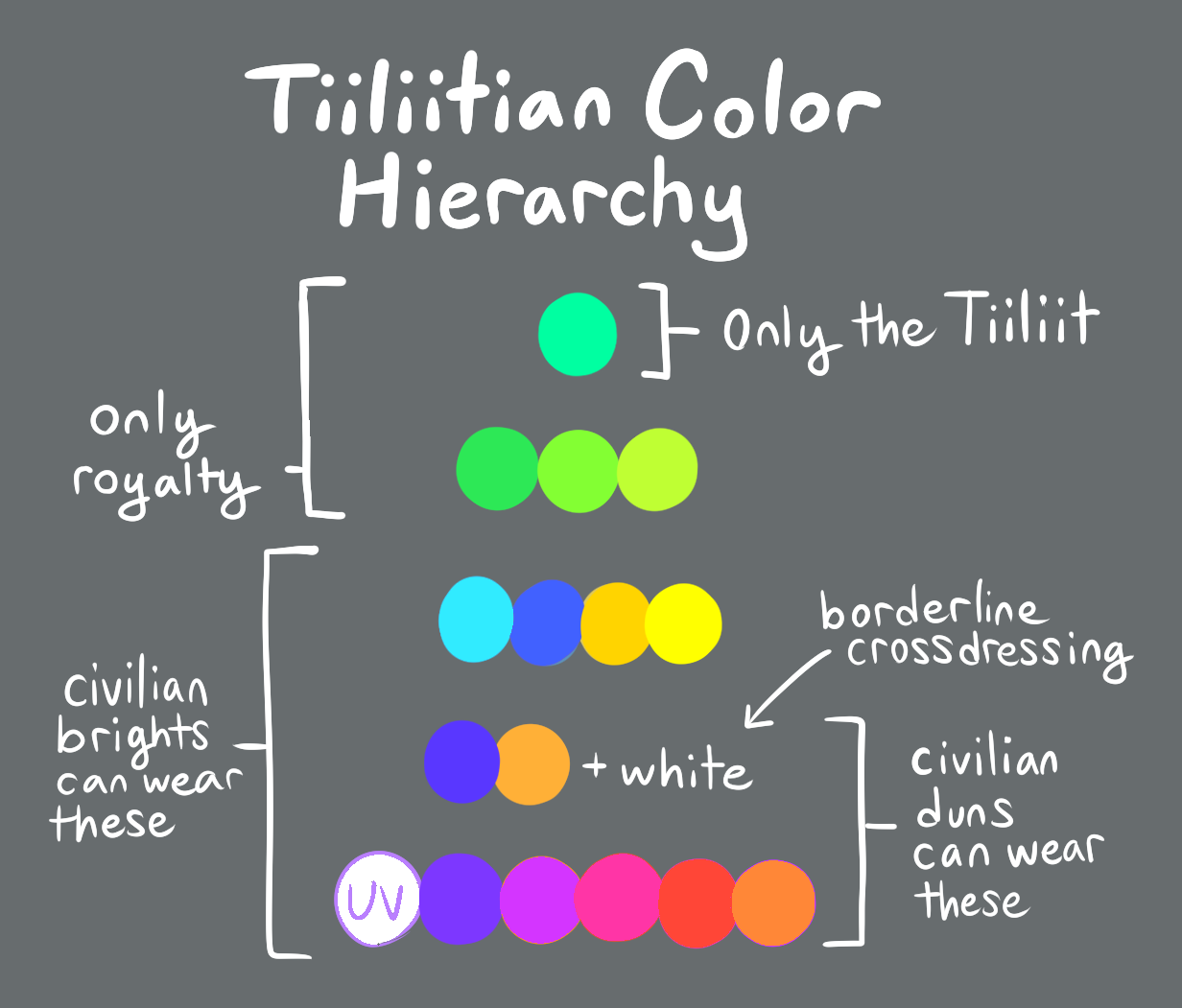
Tiiliitian society has even more specific rules about color, mostly greens. Green hues are exclusively worn by royalty, and a specific shade of mint green is only worn by the Tiiliit, their monarch. Commoners can possess items with these colors, but wearing them within the legal reach of the dominion is a crime.
Literally translated “flesh-lovers,” Carnalists’ name refers to their embracing of sexual freedom, body modification, and hedonism. They frequently wear clothing as skimpy as they can (or can’t) get away with under decency laws— neck and torso exposure is a frequent point of controversy in skimmer dominant cultures. The subculture is also very accepting of queer avians, with a style of dress that doesn’t change much between sexes and spiritual beliefs about souls being fluid and androgynous. The colors they wear and pattern aesthetic they use to decorate also reflects the subculture name, as magenta is the color of spilt blood and orange is the color of bare flesh (which is associated with violence too, because pale skin is only visible on a plucked avian).
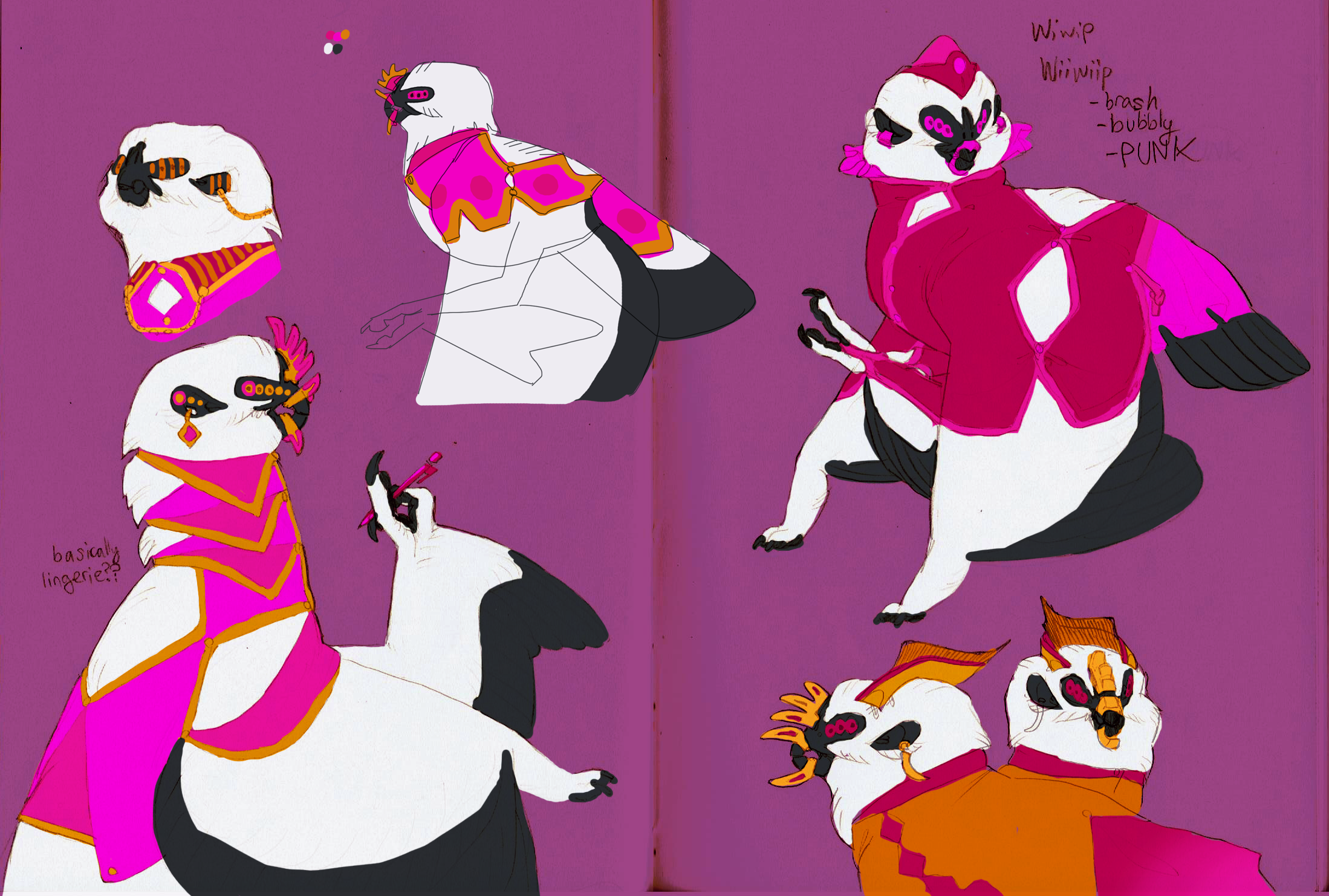
Carnalists are big on body modification, and view it as a very futuristic practice. Avian bodies are fairly delicate and historical practices of deliberate self injury, even ear piercings, are rare on the homeplanet. But improving medical technology has made body mods safer than ever before, and taking influence from alien culture has carnalists trying all kinds of things to themselves. In addition to supporting piercings, avian ears are very rigid and well suited for elaborate patterns of removed chunks, gauges, cutting and grafting strips of flesh into knots and loops. Feather dying is of course seen in addition to makeup, but feather plucking (partial or whole body), feather splitting, and decorative clippings can also be done to wild effect.
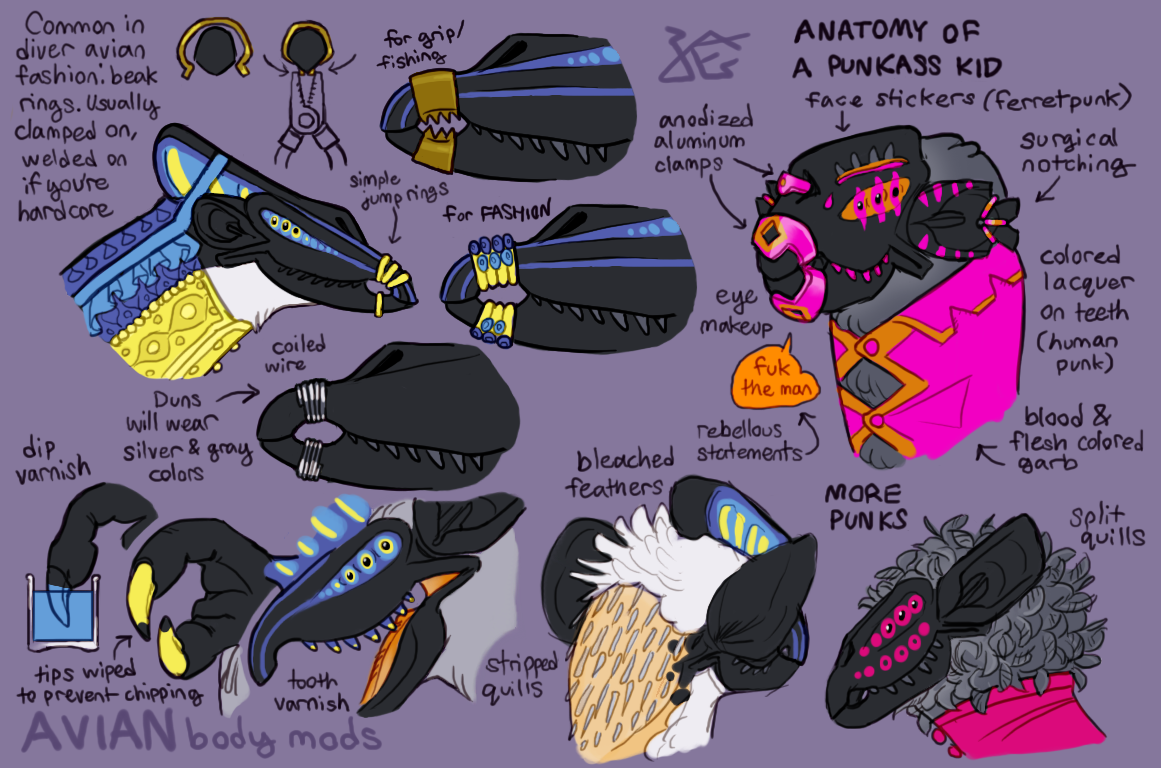
Politically, Carnalists are mostly anarchists and communists. The movement tends to be especially popular with non-skimmers living under skimmer colonialist authority.
Concealists were mostly funded by brights rejecting traditional expectations of their bodies, namely that they should be competing with other brights for sexual attention, but the hyper-dual androgyny of the movement has attracted a fair number of duns as well. They wear a lot of blacks (a dun-associated color) and whites (a bright-associated color) with different ratios sometimes dependent on how the individual feels about their gender. The pointed absence of any saturated colors removes sexual undertones from their dress, though, as does their tendency to wear things that obscure the shape of their body through pattern and bagginess.
Many Concealists reject sex entirely, and will either meditate or take chemical suppressants during the mating season. They also generally disapprove of recreational drugs and excess socializing, viewing these as corrupting influences. The most extreme Concealists undergo fasting and take on ascetic lifestyles and distance themselves from unnecessary social connections. Despite the comparison to monks or nuns, they also tend to reject spirituality as another corrupting social influence.
Concealist political views are a bit scattered, ranging from anarchists who don’t like the hedonism of Carnalists to libertarians who think avian society should be even less social. Demographically, most concealists are skimmers living under skimmer hegemony.
The avian homeplanet is host to several thousand more languages than there’s time to write about here, but the two most commonly encountered in space belong to the large skimmer nations, the Wiarii Empire and The Dominion of Tiiliit.
Wiariian is a language from the skimmer archipelago written with an ideographic script that descended from pictographs. It is from the same language tree as Tiiliitian. Their native counting system is base 8, but base 10 has been adopted in some areas that frequently do business with humans and bug ferrets.
Tiiliitian used to share the Wiariian ideographic characters, but following the creation of the modern Dominion of Tiiliit, an alphabet inspired by the syllabary scripts of some of the diver avian languages was devised. The old character system was criticized as being difficult to learn at a time when more and more of the workforce needed to read to be effective at their jobs. Tiiliitian draws the shape of its glyphs from Wiariian, but divides them into consonant diacritics and vowel characters. Although Tiiliitian only has 5 core vowel sounds, each of them can have one of 16 tonal combinations. In total, there are 60 vowel characters.
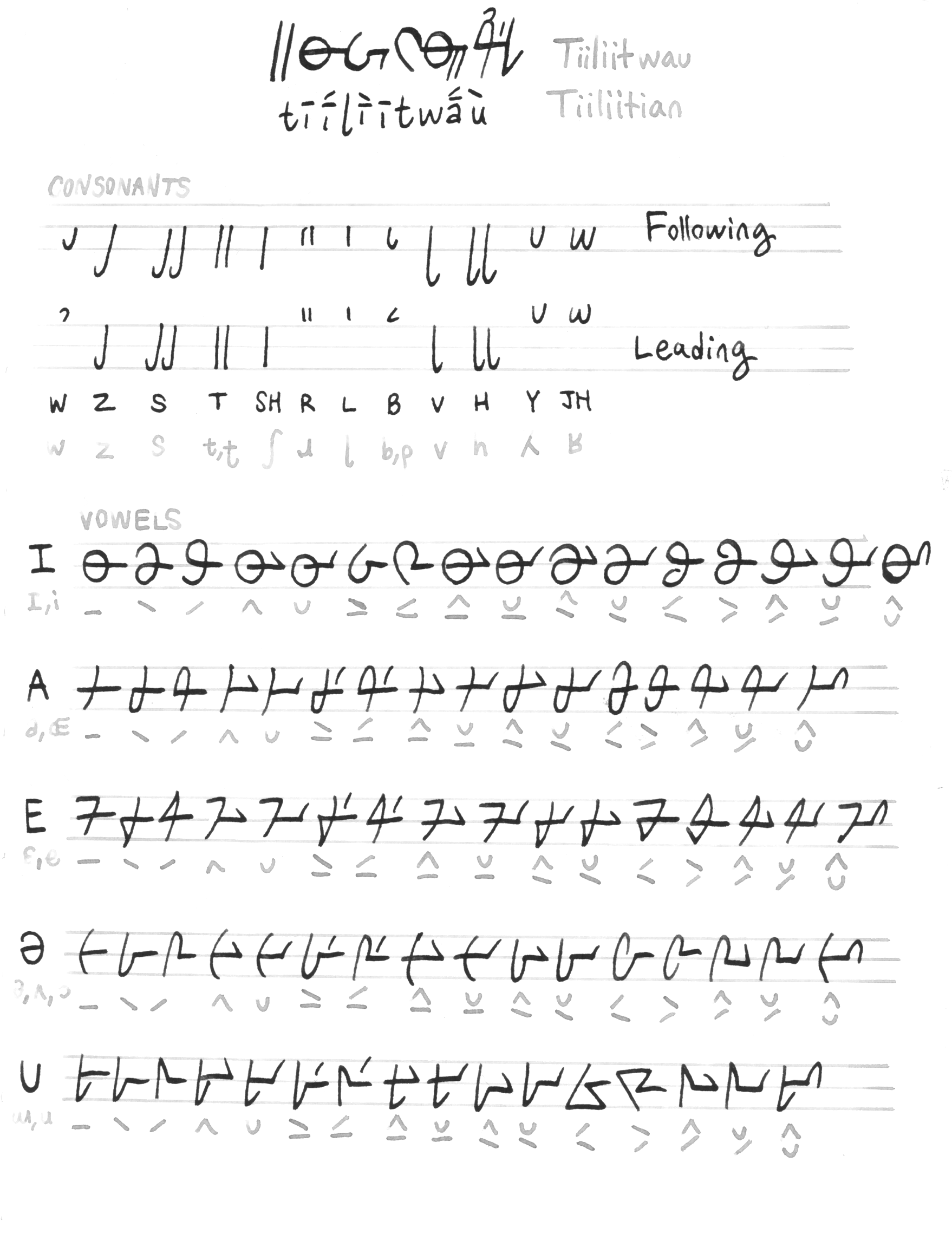
Despite mostly using the modern alphabet, formal Tiiliitian writing will sometimes use ideographs to refer to proper nouns, especially nations and royal titles.
Tiiliitian has complex gendered grammar and many sentences require gendering yourself as a speaker and the person you are speaking to. Nouns and verbs all fall into either the bright or dun gender categories, and linguistically non-avian aliens are considered brights. Bright is also the default gender for unfamiliar subjects, though if the subject has enough traits associated with duns, a Tiiliitian speaker might gender it as such.
Religion on the skimmer avian archipelago has historically been linked to monarchy, with several kingdoms each considering their reagent to be the living avatar of a monotheistic deity. This caused many conflicts and eventually the conquest of the entire archipelago by the Wiarii Empire, which later spread to conquest and colonization of other islands and the north and south poles.
Several hundred years ago, following a secularization movement and internal tension on the archipelago, there was a civil war between the Wiarii Empire and a faction of skimmers rallying around the Tiiliit, a charismatic leader with a green crest mutation who advocated for a form of monarchy based around scientific principles of evolutionary fitness. This secularist movement tore through the colonized regions, often squashing out local religious traditions, which Tiiliitians saw as unscientific and backwards. The new Dominion of Tiiliit is a larger superpower than the Wiarii Empire in the modern day, and is responsible for most of avian colonization of their local star system.
Despite its secular ideological lean, in the end, the secularist Dominion of Tiiliit ended up mirroring a lot of the theocratic monarchy it sought to replace. Although their large empire has democratic councils in many places, the Tiiliit remains the supreme authority, and the position is inherited. Bright descendants of the Tiiliit who share the green crest mutation are chosen by the reigning Tiiliit, and other blood relatives of the Tiiliit often enjoy royal positions in regional governments.
The cultural myths of the Wiarii theocracy still have a hold on the skimmers of the modern day, as well. The Wiarii creation story tells that god is a bright who filled the empty planet with eggs, who were then born out of the ground as brights. These brights asked for stronger and larger companions to help them do the laborious tasks of building a society, so God took the soil of the islands and made it into duns. God warned brights not to mate with them, as God had with the soil of the planet, because the primordial avians were immortal and if they sinfully produced life as God had, they would become too close to being gods, challenging God’s supreme authority, and in the process they would foolishly overpopulate the archipelago and suffer.
But, the primordial avians disobeyed God and mated with one another in the first spring. As a punishment for this primordial sin, they were made mortal. Those avians who had done acts of sodomy (non-reproductive sex acts) in the first spring were punished further by being transformed into deviant shapes and driven from the archipelago. According to the myth, those avians became species other than skimmers. This has colored skimmer avian views of their evolutionary relatives in the modern day, often stereotyping them as deviants, or their behavior and family structures as aberrant.
An interesting effect of this speciation myth is that skimmer avians view the kinds of genetic modification that humans do as an active fall from grace, deliberately creating new and aberrant forms of life. GMH often receive ire from skimmer avian groups who wish to project their xenophobic disgust with other species of avian onto a less local, politically charged subject.
Diver avians are a very scattered people, but have many common central myths. The diver creation story tells of the sky as a bright and the sea as a dun, who in their union gave birth to the islands that populate the ocean’s surface, as well as a plethora of minor gods. Dead duns are said to rejoin the body of the creator dun god to be reborn as islands or sea creatures, and sea burials are common practice. Dead brights are said to rejoin the body of the creator sky to become stars, and are generally burned. Islands are often thought of as having a patron god, sometimes a mythic ancestral dun and sometimes a local animal, who embodies the land.
Because of a long history of conflict and colonization by Wiariians, there are many divers who practice Wiariian religion or have syncretic belief systems that combine aspects for traditional beliefs and Wiariian. The South pole is the largest stronghold of traditional diver beliefs. Many of the previously colonized diver regions are now controlled by The Dominion of Tiiliit, which has attempted to scrub these traditions from their occupied islands to be replaced by what they consider acceptable secular practices. These acceptable secular practices almost always more closely resemble Wiariian religious practices than local diver tradition.
Flightless avians have several different widely followed religions with established doctrine, depending on the region of the continent. One popular belief system, Utsootswo, says the world spontaneously occurred after the formless primordial universe settled into the heavens, the land, and the sea. These layers transform into each other– the sea evaporates into air, air rains down onto land, land erodes into the sea. Life is part of this reincarnation cycle, transforming after death into new elemental and animal forms. This cycle, initially spontaneous, is now overseen by those ancestors who have come to a deep enough understanding to move freely through different forms, reincarnating and embodying at will and guiding the living to this state. The religion was popularized by a prophet named Utsoot Kwa who claimed to have reached this state before death, and used this ability to freely shapeshift and assist the common people of the world. They are the subject of many fables and are believed to still be around, influencing modern matters like a spirit.
Although they had conflict with Wiariians, they did not experience heavy colonization until the founding of the Dominion of Tiiliit, who attempted but largely failed to eradicate local beliefs and Utsootswo practices from their regions of the flightless continent.
Polar avians myths tend to be animist and specific to their local communities along the icy polar coast. Some have a creation myth that tells of a god forming the first people out of compacted snow. Some tell of a creation myth where the first people and animals were born from mossballs. Many tell of the world being the dream of a sleeping god, and the dreams of the living are communications with that god, or visitations to the primordial state of the world, before time became linear and the material and immaterial were separated.
Like with divers, the polar region was invaded by Wiariian forces; but the cold, metal-poor land of the north pole landmass was not as valuable as the diver occupied islands of the southern hemisphere. Skimmer colonization and religious conversion efforts were not terribly strong until the most recent couple centuries, when technology allowed more of the poles to be converted to arable land, and global populations hit all time highs.
Pygmy avians have an extremely small population over a chain of isolated volcanic islands the size of Hawaii, and their traditions are highly localized. One of their more controversial spiritual practices is mortuary cannibalism, where the hepatokidneys (said to be the seat of the soul) of the dead are cured, powdered, and eaten by the other adults of their house as means of absorbing their positive attributes and cycling of their soul into the bodies of their kin. In times of famine, the entire body is consumed by their house, and the bones ground into gruel or consumed whole as gastroliths.
Failing to eat the hepatokidneys of the deceased is said to result in angry ghosts, who attempt to possess the living out of jealousy for their body. A common shamanistic practice to capture these ghosts involves the creation of drinking vessels shaped like people, which are then filled with pulpy, sugary fruit juice and placed in a window or doorway. The ghosts are said to enter the vessel believing it to be a body, and in possessing it, cause the liquid to bubble and ferment. The resulting wine is often consumed by those with illnesses believed to be caused by ghosts, as the ingestion of the ghost wine is said to neutralize the angry soul the same way ingesting their body does. This method of soul capture has become more common in modern times than cannibalism, but the practice remains in some communities.
Recorded contact with pygmies didn’t happen until only a few hundred years ago, when Tiiliitians found the islands were inhabited. At the time, a territorial war with flightless avians over continental land was a larger concern of the empire, so little effort to colonize or convert them was made. Pygmies did not escape first contact unscathed though, as non-local diseases ravaged their population and vaccine distribution was poorly managed. In the modern day their population has rebounded, and although their islands are currently part of the Tiiliitian commonwealth they remain mostly independently run.
The Wiariian Empire is a much older nation of skimmer avians than the Dominion of Tiiliit, and though also monarchist had a different, caste-based social structure. These castes consisted of royals, the dominant lineage of which held the Wiarii monarch; an upper caste of mostly military officials, priests, and scholars; a middle caste of merchants and land-holding farmers; a lower caste of servants and laborers; and those exterior to the caste system, which included sanitation workers, criminals, butchers, slaves, and other species of avians. The ideological backbone of the caste system was the idea of spiritual corruption, where the upper castes were considered more pure, and the monarch was an avatar of god themself. This often manifested as a preoccupation with health and beauty, where the ill and deformed were believed to be that way because of some internal corruption reaching the surface.
Notably, this system was also very sex-chauvinist, with duns not being members of these largely occupational castes so much as caste resources. Dun-houses where children were born and raised were caste exclusive, with brights only being permitted to mate with duns of a matching house. Lineage for the lower castes was usually only traced through the dun-house they were raised in. Courtship outside of one's own caste, or even between two houses with intra-caste enmity, often resulted in violent retaliation.
The tensions that resulted in the splitting of the Wiariian Empire came from a growing secularist liberal movement in the lower castes, which advocated for the abolishment of the caste system and merit-based social mobility for all brights. This movement was eventually united by a charismatic leader with a green crest mutation, Giiow, who had been ousted from the royal caste after their anomalous trait became apparent at puberty and labelled a result of internal corruption. After a violent rebellion and war, the Dominion of Tiiliit claimed half the skimmer archipelago and many of its colonies, which they would later expand. Giiow became the first Tiiliit of the Dominion and largely abolished the caste system, seeking to replace it with a meritocracy, which resulted in capitalist class-based social mobility.
Giiow also did not choose dunmates purely among the upper caste and was vocal about the at the time radical concept of mating freedom. In old Wiarii society, while royal might secretively dally with duns below their caste, the offspring and their dunparent were still locked into the caste of their dun-house. The Tiiliit's abolishment of caste lead to more mixed and socially mobile dun-houses, more co-ed housing, and greater economic opportunities for duns outside of parenthood. Despite this a class of royals remained, determined by the duns that the Tiiliit chose to associate with and their offspring. Those bright offspring with the green crest mutation are eligible to become the next Tiiliit, if chosen by the current Tiiliit. Green-crested brights from the Tiiliit's linage are generally considered royals as well, with less and less importance the more generations they are removed. Independently arising versions of the green mutation in the general populace get mixed responses: some, particularly lower class brights, are treated as frauds and encouraged to hide the trait, but others may use it to claim distant relation to the monarch and climb into royal society.
The modern Wiariian Empire has declined significantly in power since the Tiiliitian revolution, and while Tiiliitians have leapt into space to make thousands of off-planet colonies, their largest power base remains on the avian homeplanet where they still command a considerable amount of land and resources. The secularity and economic liberalism of Tiiliit has rubbed off on them in the half century since the rebellion, and the old caste system has become obsolete on paper... but, still has a firm grip on the common consciousness of its people. Assumed caste plays a huge role in Wiariian social mobility and job discrimination. Their central government has also abandoned monarchy and become an oligarchical republic, where local political leaders vote new individuals into the role of president.
Avians have a lot of complex musical traditions, though avian singing sounds weird and discordant to everyone else. Humans have compared their voice as similar to a yowling cat but with the split pitch of a thrush or a red-winged blackbird.
Avian sky dancing is a unique form of art among the sophonts as it uses their natural flight abilities to create spectacular aerial displays. Each of the four flying species has different local traditions. In many of them, a large flag, ribbon, or banner is dragged, or close coordination is required with other avians, making the dances extreme feats of strength, endurance, and dexterity. Polar avians are especially fond of sky dances with fire, and performers may carry torches with colored smoke, sparklers, or even a series of fireworks to release as part of the dance. This can be incredibly dangerous, for obvious reasons.
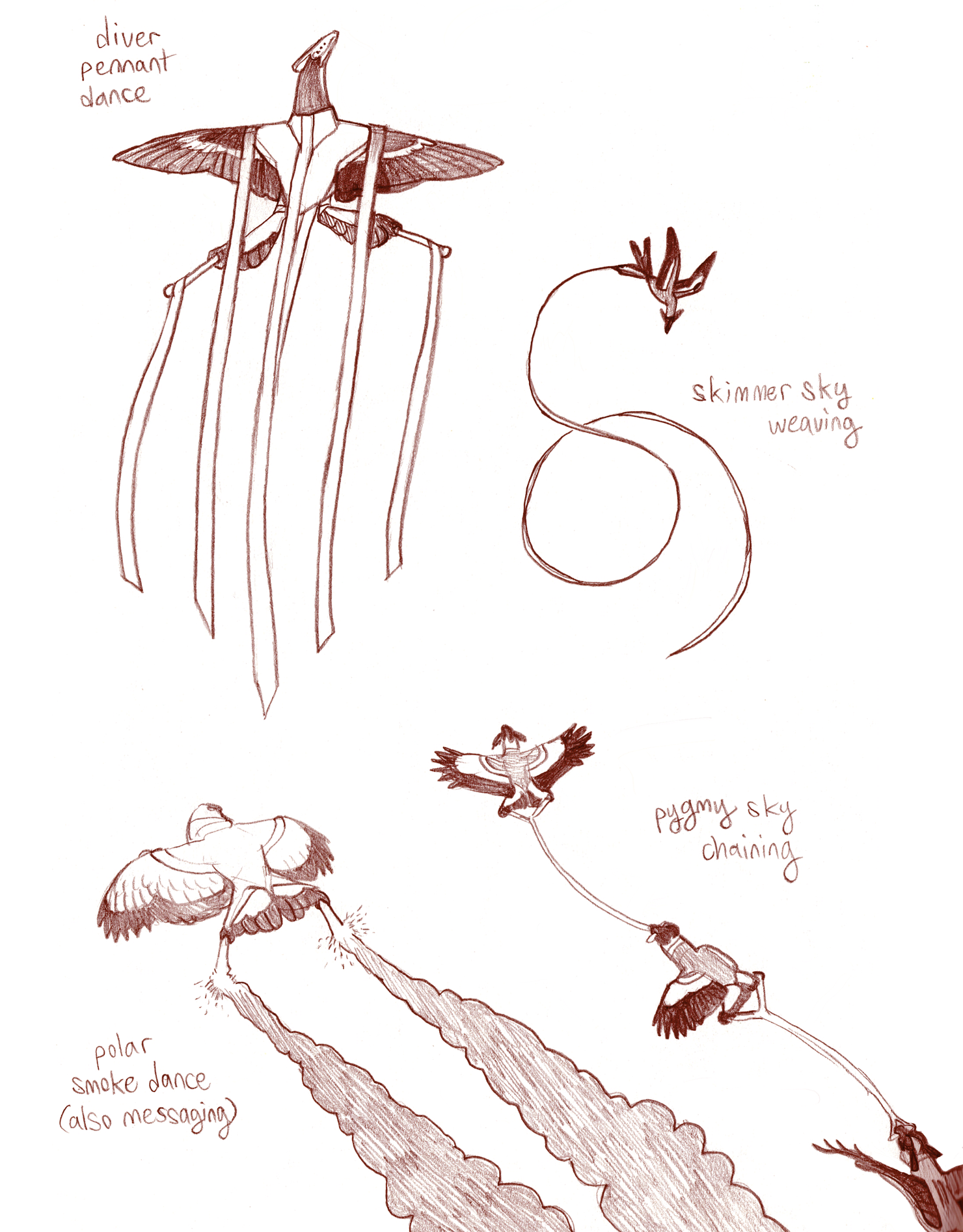
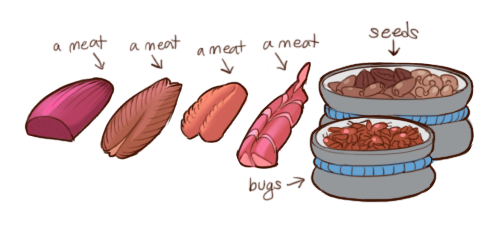
Avians swallow chunks of food whole, and have a gizzard with gastroliths to grind their food. Although the flavor of food does matter, it doesn’t remain in the mouth for very long. Tactile and visual presentation often matter far more than an exciting flavor to avian cuisine. Texture, temperature, and size of food pieces are very important to a meal, spices…. not so much. Their diet consists primarily of high calorie, fatty foods like meat, invertebrates, and seeds. They cook and process a fair amount of their foods, but may eat them raw or just warmed as well. The meat is almost always dead on arrival to the table, as it needs to be cut into swallowable sizes. Some cultures will eat live invertebrates, but many find it distasteful to eat anything before it’s been killed.
The lack of emphasis on flavor may make avian cuisine sound boring, but, even though avians rarely add spices to their food, they commonly add psychoactive drugs! Because of their large pair of hepatokidneys that filter their blood rapidly to refresh their cobalt-based respiratory pigment, almost any drug they absorb to their blood stream will be cycled out into their urine in an hour or two. Compounds that are poisonous to other species in small doses are slathered onto avian foods for the entertainment of dinner guests. Snack foods also often contain fun “side effects,” even ones marketed to kids. Addiction is a huge problem in avian culture.
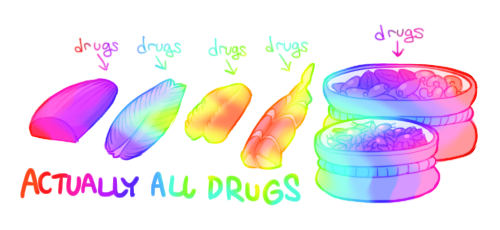
Another fascinating aspect of avian food culture relates to the indigestible part of their diet: gastroliths. A healthy avian will consume a small amount of grit and stones throughout the year, which remain in the gizzard and help grind their food. Grit is sometimes served with meals as a digestive appetizer, and novelty gastrolith rocks can be found at gift shops and corner stores in most avian cities. Some of the rocks sold as gastroliths are inadvisable shapes or materials to actually consume, but it’s left to the discretion of the buyer whether they want to eat rocks shaped like tourist attractions, cartoon characters, and celebrities, or if they just want to keep them as a curiosity.